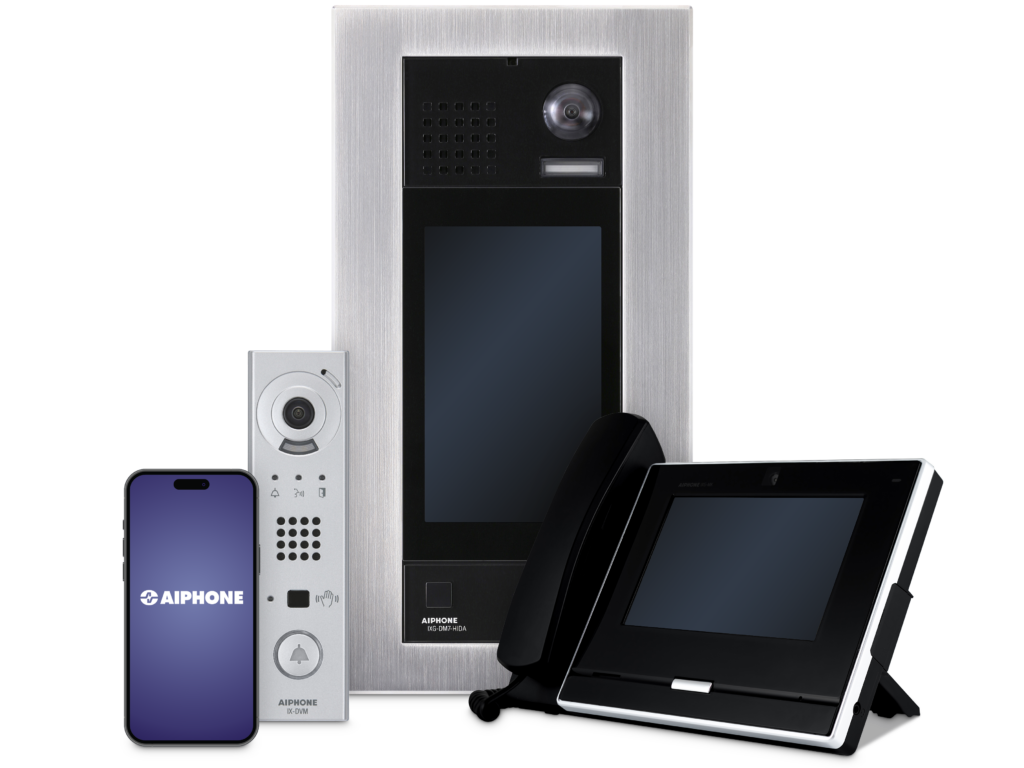Guide to Commercial Building Access Control Systems

Commercial building access control are a cornerstone of modern security, providing a structured way to control, monitor, and protect entry points. But what is access control, and how can you harness its full potential? Let’s explore everything you need to know, from foundational concepts to choosing the right system for your needs.
What is a Commercial Access Control System?
Think about the lock on your front door; it’s more than just a lock, it’s access control. You have a key, and only those with a copy of that key can enter. When you install a video intercom to identify visitors before granting them entry, you’re implementing another layer of access control.
Now, imagine scaling that concept up to a business or school campus environment, where you need to manage access for dozens, hundreds, or even thousands of people across multiple entry points and secure areas. That’s where commercial grade access control systems come in.
Commercial access control systems are sophisticated security solutions that combine hardware, software, and access control policies to regulate who can enter specific areas within a building or facility. A well-implemented business access control system operates 24/7, keeping your premises, people, and assets safe while providing detailed oversight of all access activities.
Why is Commercial Building Access Control Systems Important?
Centralized Command and Analytics
Modern access control functions as a centralized command center, enabling security professionals to monitor all access points, manage credentials, and execute protocols instantly from one interface.
Through real-time monitoring and security data analytics, security professionals gain visibility into facility usage patterns, credential activities, and potential security anomalies. These data give valuable insights for security optimization and enable evidence-based decision making.
Improve Operational Efficiency
Modern access control streamlines security by replacing physical keys with digital credentials, allowing teams to issue, adjust, or revoke access immediately.
Through advanced automation, security professionals can manage credentials and set custom access rules in bulk, while compliance reports are generated automatically, reducing manual workload and enhancing overall efficiency.
Better Compliance and Risk Management
Access control systems maintain detailed audit trails that support regulatory compliance across various industries. These records provide crucial evidence for investigations when security incidents occur and help organizations reduce their liability exposure through documented security practices.
Physical Access Control Systems vs. Logical Access Control
Before diving into the components, it's essential to understand the two primary types of access control systems:
Physical Access Control Systems control entry to physical locations, such as buildings, rooms, gates, and secure areas. These systems grant or deny access to tangible spaces using credentials like cards, fobs, or mobile devices. Physical access control protects your people, assets, and facilities from unauthorized entry.
Logical Access Control Systems manage digital access to networks, computers, applications, and data. These systems control who can access specific files, software applications, or network resources. Think of your passwords, PINs, and biometric scans, they are all forms of logical access control.
The Components of Commercial Access Control Systems
Video Intercoms
Modern IP intercom systems have advanced well beyond basic communication, now serving as integral components of access control solutions. They are foundational to entry management and visitor verification, equipped with features like video calling, mobile connectivity, and integrations. These capabilities make intercoms indispensable in today’s access control frameworks.
The visual reassurance provided by video intercoms adds a crucial layer of visitor management, enabling operators to physically verify visitors before granting access. This visual confirmation, combined with clear two-way communication, allows security personnel to not only identify who is requesting access but also understand their purpose and intentions. Such detailed verification can be all you need to prevent potential security breaches in many situations.

Access Control Panels
They serve as the system's nervous system, connecting to readers, locks, exit devices, and alarm systems. When someone presents their credential at a door, the controller processes this information, determines if access should be granted, and sends the appropriate commands to the locks or other connected hardware. You increase the system’s capacity to control more doors, sensors or alarms by adding I/O expander broads.

Door Controllers
These devices coordinate between readers, locks, and the main control panel at each entry point. Door controllers help distribute the processing load of the system and can often continue to function even if connection to the main control panel is temporarily lost, providing an important layer of redundancy in security operations.

Readers
Organizations can select reader types based on security requirements and user convenience. Modern options include card readers, keypads, and mobile credential readers.

Electronic Locks
Brands such Assa Abloy, and Allegion offer electronic strikes, magnetic locks, smart locks, or specialized exit devices, depending on the security requirements of each access point.
Access Control Management Software
The true power of modern access control lies in its management software. Security administrators can configure access levels, monitor system status, and generate detailed reports through an intuitive interface with customizable dashboards. Advanced access control software offers open APIs and scripting capabilities, allowing administrators to easily integrate and control external applications.
Our AC Nio access control management software provides management and integrations to many existing security systems, including intrusion systems, visitor management, and video surveillance systems. It integrates all security elements into a single, intuitive interface, creating a unified platform that enhances operational effectiveness and efficiency across the organization.
How Does a Commercial Building Access Control System Work?
A series of checks begins when someone presents their credential, whether it’s a card, fob, or smartphone to a reader:
- Authentication: Verifying the identity of individuals requesting access.
- Authorization: Determining if an individual has permission to enter.
- Access: If approved, the system unlocks the door.
- Audit: Recording and tracking access attempts and movements.
The system maintains a log of all these entries and exits, creating a valuable record of who accessed what areas and when. Detailed record-keeping makes modern access control systems an essential part of building security.
Choosing the Right Building Access Control System for Your Business
Here are some helpful questions to ask yourself to better understand why you want to install access control, and what features you should look for:
- When: During what times should access be granted or restricted?
- Who: Which individuals need access to which areas?
- What: Which doors, elevators, or rooms need to be controlled?
- Where: What specific locations or resources need to be secured?
- Why: What roles or responsibilities justify access to certain areas?
Important considerations for selecting an office and commercial access control system
Scalability
Scalability stands as a primary concern for most organizations. Your building access control must not only meet your current needs but also accommodate future growth. Consider your facility’s size, potential expansion plans, and the possibility of managing multiple sites. The system’s user capacity should be scalable for future growth and upgrades.
Integration
Integration capabilities represent another vital consideration in today’s interconnected security landscape. Modern access control systems should seamlessly connect with your security infrastructure, platforms, and building management systems. Integrations create a unified security ecosystem that enhances both protection and operational efficiency. When evaluating systems, assess their compatibility with your current technology investments and future technology roadmap.
Management Features
Management features play a crucial role in the day-to-day operation of your access control system. The user interface should balance sophistication with usability, allowing security administrators to efficiently manage access rights, monitor system status, and generate reports. Consider how automated features could streamline your security operations and reduce administrative burden.
Cloud-Based vs. On-Premises Access Control
Cloud-based access control systems operate primarily through servers managed by a third-party vendor, with minimal infrastructure required on-site beyond the essential door controllers and readers.
On-premises access control systems operate on servers and hardware physically located within your facility and managed by your IT team. This traditional approach gives organizations complete control over their security infrastructure and data, with no reliance on external internet connectivity for core functions.
Cost of Ownership
Consider both immediate and long-term costs when selecting an access control system. Beyond initial hardware costs, factor in software subscriptions, and training investments to understand your true ownership costs. For businesses seeking enterprise-grade security without complexity, Aiphone’s AC Series delivers powerful access management through an intuitive platform that scales as your requirements grow.
Training and Support
Consider an access control provider that provides ongoing technical training and customer support. Security administrators need ongoing training to take full advantage of system features and maintain secure operations. Comprehensive training equips your team to use the system efficiently and with confidence.
Why Consider Aiphone AC Series Access Control System?
Aiphone's AC Nio access control management software stands out in today's market with its advanced capabilities and user-friendly design. While other access control systems demand specialized expertise, AC Nio offers enterprise-grade features that security administrators can quickly master, regardless of their technical background. Its clean and intuitive design reduces the learning curve, making it an ideal choice for businesses seeking a balance of robust capabilities and operational simplicity. AC Nio represents what truly matters in modern access control: powerful security that's genuinely simple to use.